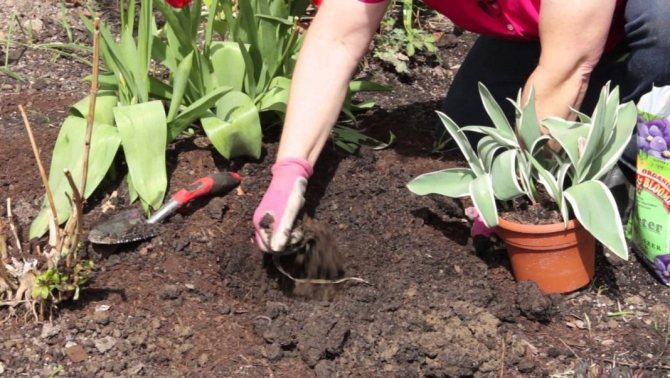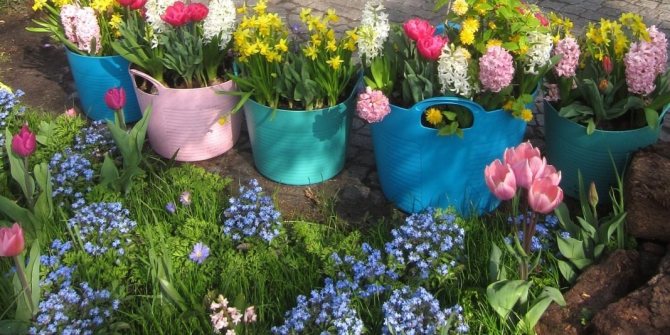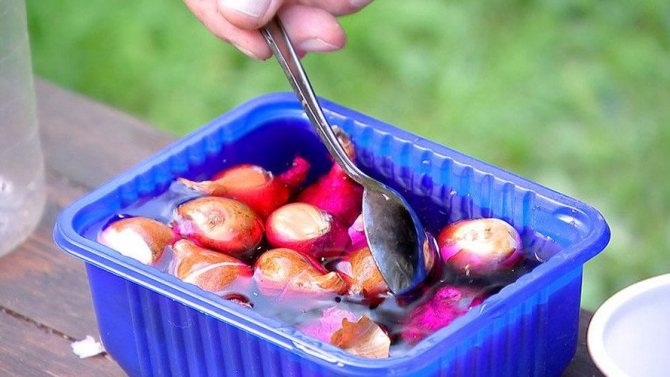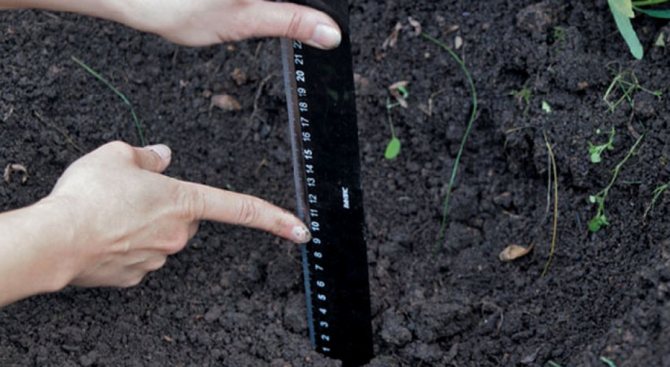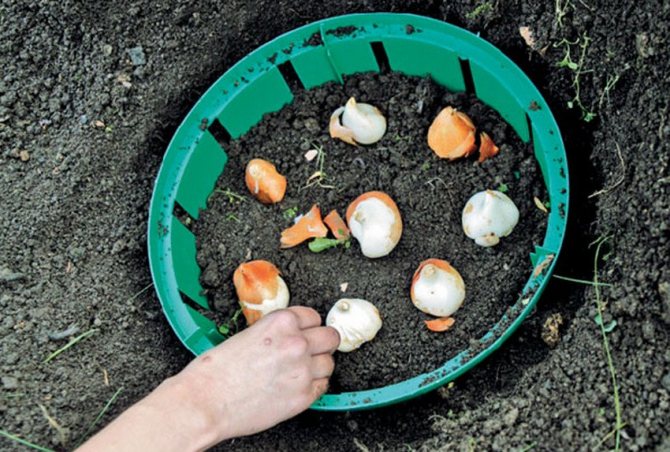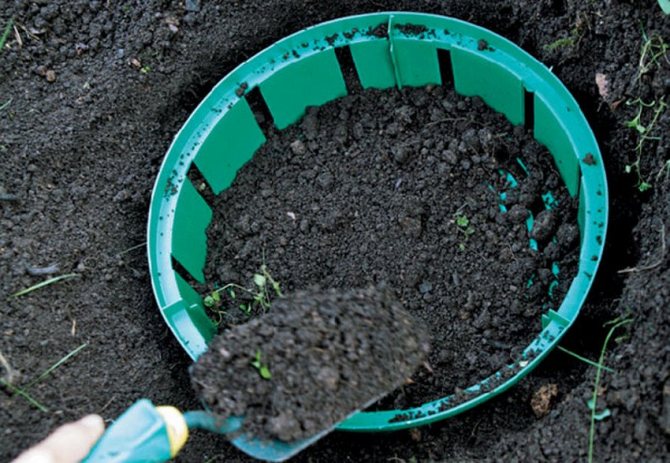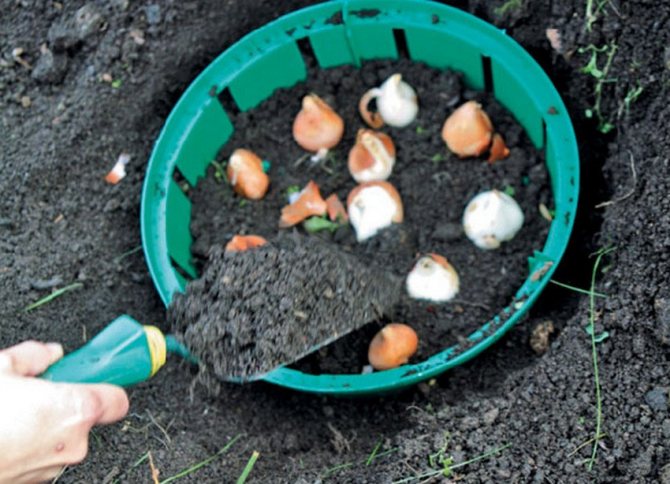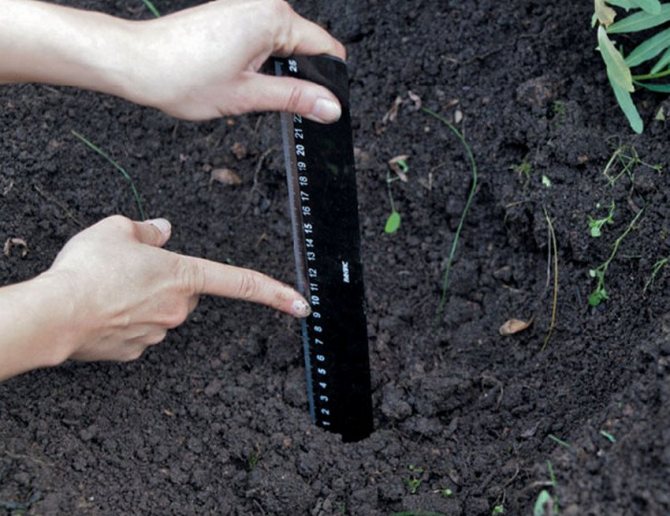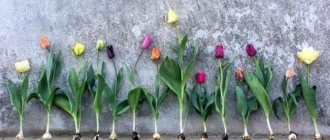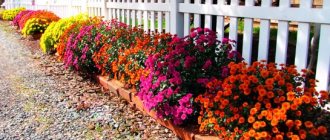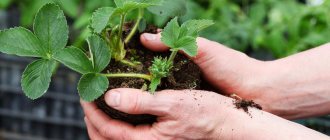The cultivation of bulbous plants is fraught with some difficulties. The need to dig up plants for the summer and then plant them in the fall, storage difficulties, problems with rodents, rot and shredding of modern hybrid varieties are familiar to every gardener. And if the baskets-nets for planting bulbs that protect against mice-voles and other garden pests are known to everyone, then the method of dropping bulbs in plastic containers - in baskets, pots and other containers - is still unpopular with us. Meanwhile, such an approach to cultivation will not only help to preserve bulbous from year to year, but also greatly simplify all the most common procedures, reducing them to a minimum.

Bulbous flowers in containers.
Advantages of growing bulbs in containers:
- Bulbs in containers are reliably protected from rodents.
- Containers with plants can be rearranged from place to place: after the loss of decorativeness, they are taken from the front part of the garden to the utility room.
- After flowering, the bulbs from the container can be easily “dug out” without fear of damage.
- Even the smallest bulbs in containers will never get lost.
- In the spring, you can decide how you will grow your plants: dig in plastic containers in the garden or put them in a beautiful planter on the terrace or in the gazebo.


Planting nuances
So, we add a container, sprinkle it with drainage, sand and part of the earth and plant the bulbs:
- With balls - we press large ones to the bottom, sprinkle with earth, distribute small bulbs from above to get seedlings at different times.
- Rows or circles - these are created in large containers or boxes.
- In layers - several layers of bulbs are placed in deep containers at different depths. The largest ones are laid out on the bottom, then a layer of earth and then the middle specimens are distributed in a checkerboard pattern in relation to the lower ones, the smallest bulbs are pressed into the upper layer of the earth. This method is called "lasagna" with onion filling. It extends the flowering period of the tulip island if each layer has a different flowering period, respectively. Small bulbs are the first to flower. If the large lower bulbs bloom at the same time, they will germinate later anyway and will not interfere with the upper flowers.
Container selection and landing
Bulbs are usually planted in plastic pots, which are dug into the ground for the winter in the suburbs and central Russia. In the spring, a plastic pot of bulbs is inserted into thecominga decorative container in diameter and brought out in a conspicuous place.
The container for planting bulbous plants should be no lower than two to three bulb heights, wide and have a sufficient number of holes for water drainage. If the container does not have them initially, you can always do it yourself in any quantity on the bottom and walls of a technical plastic pot.
At the bottom of the pot, lay a layer of drainage (gravel, expanded clay), and then the substrate. Any garden soil will do, as long as it is moisture-absorbing and breathable. The most common substrate is a 4: 1 mixture of high moor peat and sand. Fertilizers can not be used, all future parts of the flower and leaves are already laid in the bulb itself.
If you are planting several bulbs in one container, make sure that they do not touch.
Disadvantages of dropping
Of course, like any other growing method, dripping has its drawbacks.
The main and most serious argument against this growing method is the need for some investment in the containers themselves. But in fact, this method rather "helps", because it allows you to continue to use old unnecessary containers without requiring the purchase of new ones.
Of course, plastic practical containers, which in garden centers are called so - plastic baskets for bulbs - can be bought on purpose, but you cannot put them to other pottery containers and their volume is limited to 30 cm.But other containers are also ideal for this purpose. :
- old plastic pots in "poor" condition, even with cracks or damage, chips or other injuries that you cannot use for their intended purpose for potted gardens or decorating rooms, balconies and terraces;
- garden plastic utensils, including half-cut buckets and bowls that "have served their purpose";
- kitchen and construction plastic buckets that can be used for plants, cut to the desired height;
- plastic boxes lined with mesh or agrofiber;
- any other not too deep plastic containers, utensils and dishes.
The main and only condition: in the containers in which you plan to plant bulbs and add them to the soil, the water should not stagnate and the permeability of the soil should be equal to the usual cultivation in open soil. A sufficient number of holes for water drainage, if the container does not have them initially, you can always make yourself in any quantity, both at the bottom and on the walls.


A group of early spring bulbous flowers. <>
But what really will have to be taken into account is the difficulties of transporting around the site and taking out a heavy container filled with earth: a large bucket of bulbs will weigh a lot. True, the containers are smaller and the standard baskets are not that heavy, and transportation around the site can always be simplified with the help of garden equipment. All the same, efforts, and even more so the time spent on digging in and digging out containers, will take much less than planting and summer storage of each individual bulb.
Planting plants in plastic containers that you plan to drop into the soil is best done in the fall, at the time of planting all spring bulbs. For tulips, the planting season starts in the second half of August, after which you can start planting hyacinths (gladioli and other bulbs are planted at the same time as just in the soil). Lay drainage on the bottom of the tank, check the number and size of the holes for the water drain. Use good quality, loose and fertile garden soil or ready-made substrate.
Storage in the winter of a container with bulbous crops
The bulbs are either first planted in containers in the fall and immediately put the containers in the soil, or first they dig in the pots, fill them with soil, and then plant the bulbs in them, in this case you will not have to carry heavy pots with soil in the fall.
In the conditions of the middle lane and the Moscow region, it is better to dig a pot of bulbs into the ground to its full height, and cover it with lutrasil or spruce branches on top. In the spring, the pots are dug up, placed in a sunny place and watering begins.
If you want to get the coloratplants ahead of time, then simply leave the pot with planted bulbs outside until the first frost... After that, move the pots with bulbs for the winter to a cold dark room (a basement, an unheated greenhouse, a greenhouse or a loggia will do). With "dry wintering" bulbs can stimulate earlier flowering.
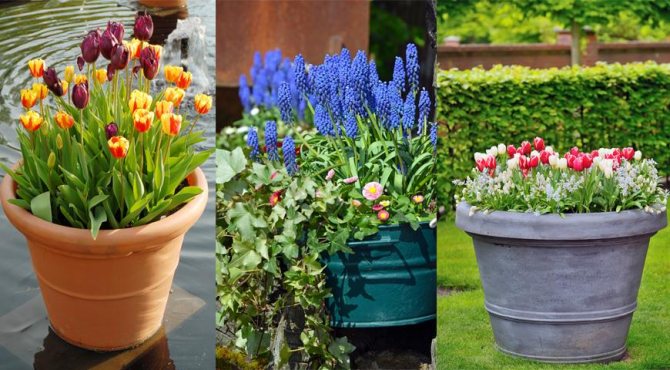

Tulip care
Caring for basket tulips is no different from caring for regular flower beds. It includes watering, loosening, weeding and feeding regularly.
Although loosening and weeding may not be necessary if good soil is used.
In the spring, fertilizing is carried out with a complex fertilizer containing nitrogen. It is essential for rapid development. Top dressing with phosphorus and potassium is applied before flowering.
You can dig up baskets of bulbs after flowering and remove from a dark place. In warm regions, you can leave them in the soil, insulating them with sawdust or peat. It is not recommended to use pine needles, tulips do not like resin.
Tulips are gentle messengers of spring, which, after primroses, are among the first to bloom on our site. Today, a wide variety of these wonderful flowers are on sale, and every gardener will be able to find something close to their liking. Distinctive qualities of various varieties - unpretentiousness, different timing and duration of flowering, a wide variety of shapes, sizes and colors.
Many summer residents are interested in when is it better to plant tulips - in spring or autumn, what to focus on in order not to miss the deadline?
Autumn planting is most suitable for tulips. For central Russia, the optimal time is from the end of September to the beginning of the second decade of October. You need to focus primarily on the temperature of the soil. Optimum values are from +7 to +9 C.
Even if for some reason the deadlines are missed, you can still plant tulips in the exhaust gas until the beginning of December! The main thing in this case is to better cover the plantings with spruce branches, fallen leaves and throw a thick layer of snow on top.
Many summer residents use tulips in mixed plantings, in which some plants bloom earlier, others later. A reasonable question arises - how to hide faded tulips that have begun to dry out in time so that they do not spoil the general appearance of the flower bed?
One of the elegant solutions is to plant tulips in autumn in buckets or small containers (same as above). During the abundant flowering in the spring, you can put flowers in the most prominent place, in the center of the composition, and by the time of wilting, rearrange them somewhere on the outskirts of the site. It is very convenient!
At the bottom of the planting containers, place expanded clay, pieces of broken brick, pebbles or any other suitable drainage. Fill the space above them with fertile soil. The bulbs should be planted to a depth of about 15-20 cm. Immediately after planting, containers with tulips should be dug in on the site, and covered with spruce branches or dry foliage from above. After the first snow falls, also connect it as an additional shelter (scoop up for planting).
It is possible not to leave tulips to winter outdoors, but to transfer them to a cool cellar with a minimum above-zero temperature. In this case, you will only need to make sure that the soil in the tub always remains moist and does not dry out.
Published: 2018-10-02 Ilya
Bulb crops for containers
Hyacinths.
The healthiest bulbs are selected for planting, with a diameter of more than 5 cm. The bulbs are planted in pots with soil prepared from an equal amount of peat and sand or earth and sand.
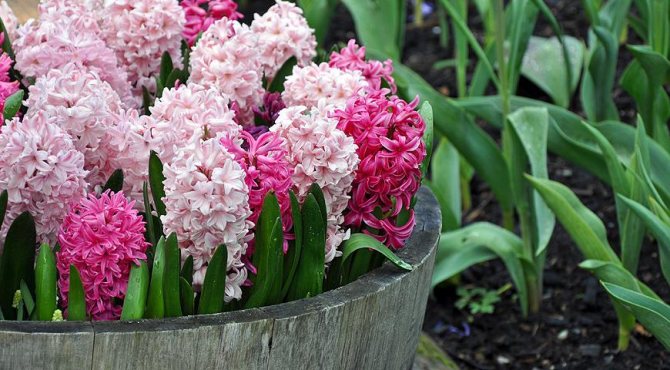

Crocuses
Numerous varieties of spring crocus are usually used for planting. Large-flowered (so-called Dutch) hybrids are very popular. Crocus corms are planted in a substrate of sod and leafy soil, peat and sand (1: 1: 0.5: 0.5).


Daffodils
For planting, strong bulbs (with a diameter of more than 4 cm) of early and mid-early flowering periods are selected.
Lilies
Lilies in containers grow very well, and in almost all varieties. At the same time, lily bulbs, unlike most bulbous crops, can be planted in containers both in autumn and spring.In any case, they will delight you with their flowering: from the moment of planting to flowering, it takes about 10-14 weeks. Blooming lilies can be obtained by forcing at any time of the year.
When choosing planting material, it is better to pay attention to medium-sized and low-growing varieties of lilies. The optimal time for planting bulbs is the second half of August or early September. If you purchased the material later, it is best to postpone planting until spring. A soil mixture suitable for lilies consists of sod and leafy soil, humus and coarse sand. You can add a long-lasting complete mineral fertilizer to the soil.
In container planting, lily bulbs are best used once, then plant them in the garden.
Tulips
Suitable for planting young healthy bulbs with a diameter of 3-4 cm, regular shape. They are planted from early September to November.
The bulbs are freed from dry covering scales (this way they take root faster) and planted in pots filled with loose soil (half earth and half sand). The bulbs should "sit" in the soil tightly, but not touch each other, the substrate thickness under them is at least 8-10 cm. In order for the plants to look the most decorative in the flowering state, the flat side of the bulb should be turned to the wall of the pot, and not inward. Then the first bottom sheet will also face outward.
This method of growing tulips is especially good for collectors: varieties can be grown in separate pots without fear of confusing the bulbs. In addition, tulips are planted in containers more densely than in the ground: this allows you to achieve the maximum decorative effect of plants.
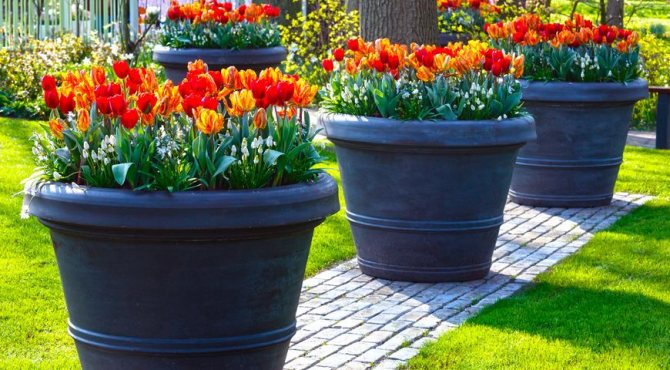

Cannes
Cannes love spacious containers, as their rhizomes grow in breadth. However, it all depends on the type of plants: mini-cannes with a height of 70-80 cm will agree on pots with a diameter of 25-30 cm, undersized cannes up to 50-60 cm, they will feel good in containers with a diameter of 18-20 cm, dwarf cannes up to 40-50 cm will grow well and bloom in pots up to 20 cm in diameter. If you plant several plants in one container, it is better to use a larger container.

